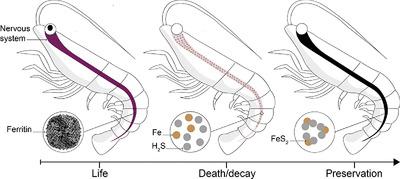Our official English website, www.x-mol.net, welcomes your
feedback! (Note: you will need to create a separate account there.)
Biogenic Iron Preserves Structures during Fossilization: A Hypothesis: Iron from Decaying Tissues May Stabilize Their Morphology in the Fossil Record.
BioEssays ( IF 3.2 ) Pub Date : 2020-04-27 , DOI: 10.1002/bies.201900243 Farid Saleh 1 , Allison C Daley 2 , Bertrand Lefebvre 1 , Bernard Pittet 1 , Jean Philippe Perrillat 1
BioEssays ( IF 3.2 ) Pub Date : 2020-04-27 , DOI: 10.1002/bies.201900243 Farid Saleh 1 , Allison C Daley 2 , Bertrand Lefebvre 1 , Bernard Pittet 1 , Jean Philippe Perrillat 1
Affiliation

|
It is hypothesized that iron from biological tissues, liberated during decay, may have played a role in inhibiting loss of anatomical information during fossilization of extinct organisms. Most tissues in the animal kingdom contain iron in different forms. A widely distributed iron-bearing molecule is ferritin, a globular protein that contains iron crystallites in the form of ferrihydrite minerals. Iron concentrations in ferritin are high and ferrihydrites are extremely reactive. When ancient animals are decaying on the sea floor under anoxic environmental conditions, ferrihydrites may initialize the selective replication of some tissues in pyrite FeS2 . This model explains why some labile tissues are preserved, while other more resistant structures decay and are absent in many fossils. A major implication of this hypothesis is that structures described as brains in Cambrian arthropods are not fossilization artifacts, but are instead a source of information on anatomical evolution at the dawn of complex animal life.
中文翻译:

生物铁在化石化过程中保留结构:一个假设:来自腐烂组织的铁可以稳定它们在化石记录中的形态。
据推测,生物组织中的铁在腐烂过程中释放出来,可能在抑制已灭绝生物化石化过程中解剖信息的丢失方面发挥了作用。动物界的大多数组织都含有不同形式的铁。广泛分布的含铁分子是铁蛋白,一种球状蛋白质,含有水铁矿矿物形式的铁微晶。铁蛋白中的铁浓度很高,而且水铁矿的反应性极强。当古代动物在缺氧环境条件下在海底腐烂时,水铁矿可能会启动黄铁矿 FeS2 中某些组织的选择性复制。这个模型解释了为什么一些不稳定的组织被保存下来,而其他更具抵抗力的结构会腐烂并且在许多化石中不存在。
更新日期:2020-04-27
中文翻译:

生物铁在化石化过程中保留结构:一个假设:来自腐烂组织的铁可以稳定它们在化石记录中的形态。
据推测,生物组织中的铁在腐烂过程中释放出来,可能在抑制已灭绝生物化石化过程中解剖信息的丢失方面发挥了作用。动物界的大多数组织都含有不同形式的铁。广泛分布的含铁分子是铁蛋白,一种球状蛋白质,含有水铁矿矿物形式的铁微晶。铁蛋白中的铁浓度很高,而且水铁矿的反应性极强。当古代动物在缺氧环境条件下在海底腐烂时,水铁矿可能会启动黄铁矿 FeS2 中某些组织的选择性复制。这个模型解释了为什么一些不稳定的组织被保存下来,而其他更具抵抗力的结构会腐烂并且在许多化石中不存在。









































 京公网安备 11010802027423号
京公网安备 11010802027423号